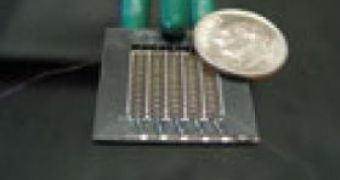The newly developed solid-state device has no moving parts thus it is silent, ultra-thin, requires low power to run and, best of all, needs roughly no maintenance, which pretty much makes it ideal for the next generation of microprocessor cooling system for laptops and other electronic devices. The solid-state microfan, created through the National Science Foundation's Small Business Innovation Research program, is currently the most efficient fan as far as size and power consumption ratio go.
In comparison to a typical mechanical fan which is four times larger, the solid state device is able to produce more than three times the air flow rate. "The RSD5 is one of the most significant advancements in electronics cooling since heat pipes. It could change the cooling paradigm for mobile electronics," says Dan Schlitz from Thorn Micro Technologies, Inc.
RSD5 has been presented this Monday at the Annual Semiconductor Thermal Measurement, Modeling and Management Symposium, and represents the achievement of nearly six years of research into alternative cooling systems. Its main design incorporates conductor wires through which electrical current is being circulated. While powered, the wires generate micro-scale plasma flows. Also, the wires are encased between two uncharged conducting plates, which surround the individual wires with half-cylindrical shape.
Flowing current through the wire creates a powerful electric field which ionizes the air in vicinity, which then starts to flow towards the uncharged plates where the gas becomes neutral once again. "The technology is a breakthrough in the design and development of semiconductors as it brings an elegant and cost effective solution to the heating problems that have plagued the industry," says Juan Figueroa from NSF.
The corona wind effect, as the phenomenon is called, is known to exist for decades, but until now nobody has really taken the initiative to create a micro-scale discharge device, which can be used as a microfan for computer processors. RSD5 can produce winds up to 2.4 meters per second without the risk of sparks or spontaneous electrical arcing inside the airflow. RSD5 is an integral part of the heat sink, which reduces the size of the fan and enhances the air flow at the same time.
According to Schlitz, RSD5 is able to efficiently cool a 25-watt silicon chip, regardless of the fact that the fan has an area of only 1 cubic centimeter, which may enable the direct integration onto computer chips one day. Additionally, the solid-state microfan is much more effective against dust accumulation, one of the worst enemies of the cooling systems, as it also has air-filtration capabilities.

 14 DAY TRIAL //
14 DAY TRIAL //